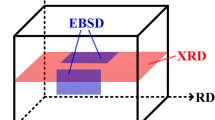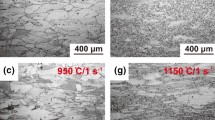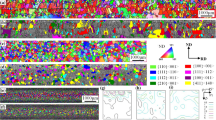Abstract
Strain path changes during clock rolling cause more serious interaction between adjacent grains, resulting in the occurrence of interactive regions (IRs) with random orientations. Furthermore, plenty of new grains with relatively random orientations are introduced by the subsequent annealing of these IRs. The morphology of the IR and the origin of random orientations were therefore investigated in this study, and the electron backscatter diffraction technique was used to characterize crystallographic orientations of nuclei and deformed matrices. A short-time annealing was imposed on a specimen to catch the transient nucleation behaviors. The results indicate that the orientations of nuclei are similar to their surrounding deformed matrices, especially the points with larger local-misorientation. Additionally, the shape of new grains depends on where it forms, and it is suggested that this fact mainly results from the great difference in stored energies between deformed matrices with {111} and {100} orientations.









Similar content being viewed by others
References
C.A. Michaluk: Correlating discrete orientation and grain size to the sputter deposition properties of tantalum. J. Electron. Mater. 31, 2 (2002).
Z. Zhang, L. Kho, and C.E. Wickersham: Effect of grain orientation on tantalum magnetron sputtering yield. J. Vac. Sci. Technol., A 24, 1107 (2006).
M.T. Robinson and A.L. Southern: Sputtering experiments with 1- to 5-keV Ar+ ions. III. Monocrystal targets of the hexagonal metals Mg, Zn, Zr, and Cd. J. Appl. Phys. 39, 3463 (1968).
M.T. Robinson and A.L. Southern: Sputtering experiments with 1- to 5-keV Ar+ ions. II. Monocrystalline targets of Al, Cu, and Au. J. Appl. Phys. 38, 2969 (1967).
F.J. Humphreys: Nucleation in recrystallization. Mater. Sci. Forum 467–470, 107 (2004).
D. Raabe: Recovery and recrystallization: Phenomena, physics, models, simulation. In Physical Metallurgy, Vol. 2, 5th ed., D.E. Laughlin and K. Homo eds. (Elsevier, Amsterdam, the Netherlands 2014); p. 2291.
F.J. Humphreys and M. Hatherly, eds.: Recrystallization and Related Annealing Phenomena, 2nd ed. (Elsevier, Oxford, U.K., 2004).
C. Deng, S.F. Liu, H.Y. Fan, X.B. Hao, J.L. Ji, Z.Q. Zhang, and Q. Liu: Elimination of elongated bands by clock rolling in high-purity tantalum. Metall. Mater. Trans. A 46, 5477 (2015).
Y.H. Liu, S.F. Liu, J.L. Zhu, C. Deng, H.Y. Fan, L.F. Cao, and Q. Liu: Strain path dependence of microstructure and annealing behavior in high purity tantalum. Mater. Sci. Eng., A 707, 518 (2017).
S.F. Liu, H.Y. Fan, C. Deng, X.B. Hao, Y. Guo, and Q. Liu: Through-thickness texture in clock-rolled tantalum plate. Int. J. Refract. Met. Hard Mater. 48, 194 (2015).
C. Deng, S.F. Liu, J.L. Ji, X.B. Hao, Z.Q. Zhang, and Q. Liu: Texture evolution of high purity tantalum under different rolling paths. J. Mater. Process. Technol. 214, 462 (2014).
D. Raabe: On the orientation dependence of static recovery in low-carbon steels. Scr. Metall. Mater. 33, 735 (1995).
W.B. Hutchinson: Deformation substructures and recrystallisation. Mater. Sci. Forum 558–559, 13 (2007).
D.I. Kim, J.S. Kim, J.H. Kim, and S.H. Choi: A study on the annealing behavior of Cu-added bake-hardenable steel using an in situ EBSD technique. Acta Mater. 68, 9 (2014).
S.I. Wright, M.M. Nowell, and D.P. Field: A review of strain analysis using electron backscatter diffraction. Microscopy and microanalysis 17, 316 (2011).
H. Fan, S. Liu, L. Li, C. Deng, and Q. Liu: Largely alleviating the orientation dependence by sequentially changing strain paths. Mater. Des. 97, 464 (2016).
R.A. Vandermeer and J.W.B. Snyder: Recovery and recrystallization in rolled tantalum single crystals. Metall. Trans. A 10, 1031 (1979).
K. Hagihara, M. Yamasaki, M. Honnami, H. Izuno, M. Tane, T. Nakano, and Y. Kawamura: Crystallographic nature of deformation bands shown in Zn and Mg-based long-period stacking ordered (LPSO) phase. Philos. Mag. 95, 132 (2014).
M.T.P. Rez-Prado, J.A. Hines, and K.S. Vecchio: Microstructural evolution in adiabatic shear bands in Ta and Ta–W alloys. Acta Mater. 49, 2905 (2001).
B. Radhakrishnan and G.B. Sarma: Coupled simulations of texture evolution during deformation and recrystallization of fcc and bcc metals. Mater. Sci. Eng., A 494, 73 (2008).
C. Deng, S.F. Liu, X.B. Hao, J.L. Ji, Z.Q. Zhang, and Q. Liu: Orientation dependence of stored energy release and microstructure evolution in cold rolled tantalum. Int. J. Refract. Met. Hard Mater. 46, 24 (2014).
A.J. Wilkinson and D.J. Dingley: Quantitative deformation studies using electron back scatter patterns. Acta Metall. Mater. 39, 3047 (1991).
S-H. Choi and Y-S. Jin: Evaluation of stored energy in cold-rolled steels from EBSD data. Mater. Sci. Eng., A 371, 149 (2004).
S.H. Choi: Monte Carlo technique for simulation of recrystallization texture in interstitial free steels. Mater. Sci. Forum 408–412, 469 (2002).
ACKNOWLEDGMENTS
The present work was co-supported by the National Natural Science Foundation of China (Grants Nos. 51421001 and 51701032), the Major National Science and Technology Projects of China (No. 2011ZX02705), and the Chongqing Science and Technology Commission in China (CSTC, 2017jcyjAX0094).
Author information
Authors and Affiliations
Corresponding author
Rights and permissions
About this article
Cite this article
Liu, Y., Liu, S., Fan, H. et al. Crystallographic analysis of nucleation for random orientations in high-purity tantalum. Journal of Materials Research 33, 1755–1763 (2018). https://doi.org/10.1557/jmr.2018.164
Received:
Accepted:
Published:
Issue Date:
DOI: https://doi.org/10.1557/jmr.2018.164




